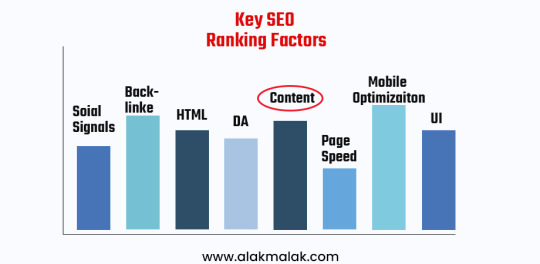#seo content marketing strategy
Text
Don't let your SEO efforts stay grounded!
At Bizionic, we specialize in crafting tailored keyword strategies that will propel your business to new heights. 🚀 With comprehensive research and competitive analysis, we'll ensure your brand rises above the competition. Contact us today for a consultation!
#digital marketing services#keyword strategy#keyword research services#key phrases#keyword targeting#seo content strategy#b2b seo strategy#enterprise seo strategy#international seo strategy#seo content marketing strategy#branding strategy#brand strategy consulting#brand strategy firm#brand visibility#startup financing for small businesses#startup business insurance#cleaning business startup#recovery startup business#startup photography business
0 notes
Text
#content marketing#content creation#content strategy#influencer marketing#seo services#search engine optimization
12 notes
·
View notes
Text
5 Key Elements of Effective Content Marketing Strategies
Effective marketing is an art where marketers analyze and try different ways to capture the attention and action of their target audience. For newer marketers or those launching a new product, sometimes there is not much information to work with, and it requires a lot of trial and error to see what will work. However, we can always find ourselves ahead of the game when we know in which direction…

View On WordPress
#blog#blog writing#content creation#content marketing#content marketing strategy#content writing#digital marketing#facebook#instagram#marketing#marketing strategy#seo#social media#social media marketing#target market#youtube
53 notes
·
View notes
Text

Read More
#ecommerce#creative writing#writers on tumblr#ecommerce business#onlineshopping#business#growth#online earning tips#digital marketing#seo#i sell content#learn#contentcreator#business growth#business strategy#business success#business setup in uae#marketing#entrepreneur#management
5 notes
·
View notes
Text
"Navigating the Digital Marketing Landscape: 7 Essential Steps for Success in Today's World"
In today's fast-paced and ever-evolving digital landscape, businesses must adapt and embrace effective digital marketing strategies to stay competitive and relevant. With consumers spending increasing amounts of time online, the importance of a robust digital marketing plan cannot be overstated. To help you succeed in this dynamic environment, we've outlined seven crucial steps that can make or break your digital marketing efforts.
1. Define Your Target Audience: The foundation of any successful digital marketing campaign is a deep understanding of your target audience. Start by creating detailed buyer personas that encompass demographics, interests, pain points, and online behavior. The more you know about your audience, the more tailored and effective your marketing efforts will be.

2. Develop a Comprehensive Strategy: A well-structured digital marketing strategy is essential for achieving your goals. Consider all relevant channels, such as social media, email marketing, content marketing, search engine optimization (SEO), and paid advertising. Align your strategy with your audience's preferences and your business objectives.

3. Content is King: High-quality, relevant content is the backbone of digital marketing. Create content that educates, entertains, or solves problems for your target audience. This can include blog posts, videos, infographics, podcasts, and more. Consistency in content creation is key to building trust and credibility with your audience.

4. Optimize for SEO: Search engine optimization is crucial for ensuring that your content and website are discoverable by your target audience. Conduct keyword research to identify relevant search terms, and optimize your content accordingly. Focus on both on-page and off-page SEO techniques to improve your website's ranking on search engine results pages (SERPs).

5. Leverage Social Media: Social media platforms offer unparalleled opportunities to connect with your audience and promote your brand. Choose the platforms that align with your target audience's preferences, and craft engaging content that encourages interaction. Paid advertising on social media can also be highly effective in reaching a wider audience.

6. Embrace Data Analytics: Digital marketing provides access to a wealth of data and analytics tools. Monitor key performance indicators (KPIs) such as website traffic, conversion rates, click-through rates, and social media engagement. Use these insights to refine your strategy, identify areas for improvement, and make data-driven decisions.

7. Mobile Optimization: With the increasing use of smartphones and tablets, it's essential to ensure that your website and content are mobile-friendly. A responsive design, fast loading times, and an intuitive user experience on mobile devices can significantly impact your digital marketing success.

In conclusion, digital marketing has become an integral part of today's business landscape. To thrive in this competitive environment, you must define your audience, create a comprehensive strategy, produce high-quality content, optimize for search engines, leverage social media, embrace data analytics, and prioritize mobile optimization. By following these seven essential steps, you can establish a strong online presence, build meaningful connections with your audience, and ultimately achieve your business objectives in today's digital world.
#digital marketing#digital learning#seo#learn digital marketing#proffesional marketer#social media marketing#content marketing#online marketing#internet marketing#mobile marketing#data analytics#target audience#strategy development#marketing stratergies
7 notes
·
View notes
Text
SEO Dominance: The Key to Online Success
1. Introduction
In today’s digital age, having a strong online presence is crucial for businesses of all sizes. The internet has become a vast marketplace, and businesses need to ensure that they are easily discoverable by their target audience. Search Engine Optimization, or SEO, plays a pivotal role in achieving this goal. In this comprehensive article, we will delve deep into the world of…

View On WordPress
#Backlinking#Content Marketing#Digital Marketing#Google Ranking#Keyword Optimization#Link Building#Mobile SEO#Off-Page SEO#On-Page SEO#Online Marketing#Organic Search#Search Engine Optimization#SEO Analytics#SEO Best Practices#SEO Ranking#SEO Strategies#SEO Techniques#SEO Tips#SEO Tools#SEO Trends#SERP (Search Engine Results Page)#User Experience (UX)#Voice Search Optimization.#Website Optimization#Website Traffic
7 notes
·
View notes
Text

#digital marketing#SEO#search engine optimization#viral content#social media#video content#website design#storytelling#brand strategy#online presence#traffic growth#content creation#engagement
3 notes
·
View notes
Text
https://adilrafeeque.com/thrissur/
3 notes
·
View notes
Text

Attract, Engage, Convert: Content Marketing's Impact on Lead Quality!
Discover the untapped potential of a robust content marketing strategy! Elevate your lead generation game and attract high-quality leads that convert effortlessly. Unleash the power of engaging content to maximize your business's growth and success. It's time to transform your approach and reap the rewards of strategic content marketing!
#b2b content marketing strategy#digital content marketing strategy#seo content marketing strategy#content strategy vs content marketing#digital marketing content strategy#social media content marketing strategy#best content marketing strategies#how to improve lead quality#lead quality#improve lead quality#lead generation services#content marketing services#content marketing world#lead optimization#high quality leads#quality leads marketing#quality leads for your business
0 notes
Text
Feeling stuck when it comes to creating content? Here's a simple guide to streamlining your content and SEO strategy with pillars and clusters.
Struggling with content creation? Learn how pillars and clusters can help streamline your content and SEO strategy.
Life’s busy, right? I don’t know about you, but I feel it’s getting busier by the minute.
You know there are soooo many things you ‘should’ be doing. Your ever-expanding to-do list is a testament to that. When you’re busy juggling daily tasks, the struggle to create consistent, valuable marketing content can be a burden. Especially high-quality content that connects with your ideal customer and…

View On WordPress
#Business writing#Business writing tips#Content Marketing#Content Strategy#Content tips#Content writer#Freelance writing#SEO content
13 notes
·
View notes
Text
Search engine optimization
Alienspost India: digital marketing agency
SEO involves optimizing a website to improve its ranking on search engine results pages (SERPs), which can help increase your reach to potential customers and support your wider digital marketing efforts. Alienskpost is a freelancers agency that provides different marketing strategies like SEO, SMM, PPC and many such others ways to improve your business in online world. Now a days online marketing is dominating over offline marketing. Without SEO or PPC you will not be able to find your own website. Post your project on Alienspost and enjoy the business world with us.
#Alienspost India#freelancers#online marketing#marketng tips#digital marketing#content marketing#search engine optimization#business strategies#SEO#PC#software development#Alienskart Web#Aliensdigital
3 notes
·
View notes
Text
Navigating The New Terrain: Google's SEO Starter Guide Update 2024 - #AffordableSEO, #AI, #ContentMarketing, #DigitalMarketing, #Google, #LocalSEO, #LocalSEOTampa, #SearchEngine, #SEO, #SEOAgency, #SEOCompany, #SEOTips, #SmallBusiness, #Tampa, #WebMarketing, #WebsiteDesign - https://localseotampa.com/navigating-the-new-terrain-googles-seo-starter-guide-update-2024-202401/
New Post has been published on https://localseotampa.com/navigating-the-new-terrain-googles-seo-starter-guide-update-2024-202401/
Navigating The New Terrain: Google's SEO Starter Guide Update 2024
The Google SEO Starter Guide is a fundamental resource for anyone looking to understand and implement Search Engine Optimization (SEO) for their website. With the digital landscape continually evolving, staying updated with the latest SEO practices is crucial for maintaining visibility and relevance in search engine results. Recently, Google announced a major update to its SEO Starter Guide, which is set to bring significant changes to how SEO is approached in 2024 and beyond.
The Evolution of Google’s SEO Starter Guide
The original version of Google’s SEO Starter Guide was a comprehensive manual that provided website owners and webmasters with essential information on optimizing their sites for better search engine rankings. This guide covered a range of topics, from site structure and content creation to mobile optimization and analytics.
Key Features of the Original Guide
Site Structure and Navigation: Emphasized the importance of a well-organized website for both user experience and search engine crawling.
Content Quality: Stressed the need for original, valuable content tailored to the target audience.
Mobile Optimization: Addressed the growing importance of mobile-friendly websites.
Use of Keywords: Offered advice on using keywords effectively within the content.
Analytics and Monitoring: Guided on using tools like Google Analytics to track performance and user engagement.
Anticipated Changes in the 2024 Update
According to recent announcements, the updated Google SEO Starter Guide is set to introduce new best practices and remove outdated advice, reflecting the evolving nature of search engines and user behavior. Here are some expected changes:
Enhanced Focus on User Experience (UX): As search algorithms become more sophisticated, UX is likely to play a more central role in SEO. The update might provide in-depth insights on creating user-centric designs and content.
Increased Emphasis on Mobile-First Indexing: With mobile searches dominating, the updated guide will probably place more stress on mobile-first indexing, ensuring sites are optimized for mobile users first.
Greater Importance on Page Speed and Performance: Site speed and performance have become crucial ranking factors. The new guide may offer advanced tips on improving site speed and overall performance.
Content Relevance and Quality: Given the advancements in natural language processing, the guide is expected to delve deeper into creating content that’s not just keyword-rich but also contextually relevant and of high quality.
Voice Search Optimization: With the rise of voice-assisted devices, the updated guide might include strategies for optimizing content for voice search.
Data Privacy and Security: In light of increasing concerns over data privacy and security, the guide may incorporate best practices for maintaining site security and user privacy.
Artificial Intelligence and Machine Learning: The guide might touch upon the growing influence of AI and machine learning in SEO and how to adapt strategies accordingly.
Implications for Website Owners and SEO Professionals
The updated Google SEO Starter Guide will be more than just a manual; it will be a comprehensive roadmap to navigating the complexities of modern SEO. Website owners and SEO professionals must adapt strategies to align with these changes. Embracing a more holistic approach to SEO, focusing on user experience, and staying informed about the latest trends and technologies will be imperative for success in the ever-changing digital landscape.
Conclusion
For businesses in Tampa, Florida, looking to enhance their online presence, Local SEO Tampa offers a comprehensive suite of services tailored to your needs. As a leading provider in the area, they specialize in optimizing your local online footprint. From leveraging local directories and enhancing Google My Business listings to content optimization and profile management, they have a proven track record in driving conversions and boosting online visibility for Tampa-based businesses. Their approach combines the latest SEO strategies with a deep understanding of the local market, ensuring your business stands out in a competitive digital landscape. Discover how Local SEO Tampa can help your business thrive in the digital world by visiting their website.
Picture Credit: Freepik
#2024 SEO Guide Update#AI#Google#Google SEO Starter Guide#Local SEO#Mobile Friendly#Mobile Web Design#Online Marketing#SEO#SEO 2024#SEO Company#SEO content#SEO in 2024#SEO Starter Guide Updates#SEO Strategy#SEO Tips
2 notes
·
View notes
Text
Mastering Your Marketing The 7 Essential Steps for Crafting a Winning Strategy

Introduction
In the dynamic and competitive landscape of business, a well-crafted marketing strategy is crucial for success. It’s more than just coming up with imaginative ideas, it involves a deep understanding of the market, competition, and the preferences of your target audience.
This article will explore the key components of a winning marketing strategy, providing a detailed, step-by-step guide to help you align your strategy with your business goals and objectives. We’ll also highlight the importance of tracking progress and making necessary adjustments to ensure ongoing relevance and effectiveness.
Step 1: Understand the Market and Target Audience
Understanding your market and target audience is the foundation of a successful marketing strategy. This involves extensive research into customer demographics, behavior, and competitive analysis.
Demographic Research
Demographic research entails a thorough analysis of customer characteristics such as age, gender, income, and location. By identifying key demographic factors, you can create a detailed profile of your ideal customer, enabling you to tailor your marketing efforts effectively. Techniques for demographic research include surveys, data analysis from websites and social media, and studying industry reports.
Types of Demographic Research
Age-Based Research
Analyzing data based on different age groups to tailor marketing efforts.
Gender-Based Research
Understanding gender preferences to create targeted campaigns.
Income-Based Research
Analyzing data based on income levels to customize messaging.
Geographical Research
Studying data based on location to identify optimal marketing locations.
Behavioral Study
Understanding customer behavior is crucial for building a successful marketing strategy. Behavioral study involves analyzing how customers interact with a brand, their purchasing habits, and decision-making processes.
Examples of Behavioral Study Methods
Purchase History Analysis
Examining past purchases to tailor marketing efforts.
Website Analytics
Analyzing website traffic, user engagement, and conversion rates.
Social Media Listening
Monitoring social media channels to understand customer sentiments.
Competitor Analysis
Beyond understanding your target audience, it’s essential to analyze the competition. Conducting a SWOT analysis (Strengths, Weaknesses, Opportunities, Threats) and benchmarking against competitors’ products, services, or processes provides valuable insights.

Step 2: Set Measurable Objectives
Once you understand your market and audience, the next step is to set measurable objectives. These objectives should be SMART: Specific, Measurable, Achievable, Relevant, and Time-bound.
Avoid common mistakes, such as setting vague or unrealistic objectives, to ensure your goals guide your marketing tactics effectively.
Breaking Down SMART Objectives
Specific
Clearly defining and articulating the objective.
Measurable
Establishing metrics for tracking and evaluation.
Achievable
Realistic goals within given resources.
Relevant
Aligning with the overall business strategy.
Time-Bound
Having a specific deadline or timeframe for completion.
Step 3: Develop a Messaging Framework
A messaging framework acts as a blueprint for consistent communication with your target audience across all channels. It includes key messages that communicate the unique value proposition of your brand.
Crafting an Effective Messaging Framework
Speak their Language
Tailor messages to resonate with your audience.
Highlight Benefits
Focus on positive outcomes rather than just features.
Consistency is Key
Ensure messages align with overall business strategy.
Step 4: Choose the Right Marketing Channels
Effectively promoting your product or service requires selecting the right marketing channels that resonate with your audience and align with your objectives.
Avoid the common mistake of spreading too thin across channels. Focus on the most effective ones for your target audience and goals.
Considerations for Choosing Marketing Channels
Know Your Audience
Understand where your audience spends time online.
Align with Objectives
Different channels suit different marketing objectives.
Budget and Resources
Choose channels feasible within your budget.

Step 5: Develop a Content Strategy
In today’s digital age, content is a cornerstone of any marketing strategy. A robust content strategy involves creating and distributing high-quality content to attract and engage your target audience.
Common mistakes include prioritizing quantity over quality and neglecting search engine optimization. Quality content builds trust and establishes your brand as a thought leader.
Building an Effective Content Strategy
Understand Audience Needs
Identify topics that resonate with your audience.
Choose Effective Formats
Tailor content formats to audience preferences.
Select Distribution Channels
Choose platforms where your audience is most active.
Step 6: Measure and Adjust
Creating a successful marketing strategy is an ongoing process that requires continuous monitoring and evaluation.
By tracking KPIs and analyzing data, you can identify effective tactics, make adjustments, and optimize future efforts.
Utilizing Key Performance Indicators (KPIs)
Website Traffic
Measure website visits.
Conversion Rates
Evaluate how well you convert leads.
Return on Investment (ROI)
Assess the profitability of your efforts.
Social Media Engagement
Track interaction on social platforms.
Customer Retention Rates
Measure customer loyalty.
Step 7: Embracing a Dynamic Approach
A successful marketing strategy should be dynamic, adapting to changing market conditions and customer needs.
Flexible Approach
Regular Analysis and Optimization
Conduct ongoing market research for up-to-date insights.
Adapt to Trends
Adjust strategies based on industry trends.
Crisis Preparedness
Be ready to adjust messaging during unexpected events.
Conclusion
A successful marketing strategy requires a deep understanding of your target audience and market. It should include measurable objectives, a cohesive messaging framework, and a well-defined content strategy leveraging appropriate marketing channels. Regular review and adaptation to changing market conditions and customer needs are crucial for long-term success. Remember, a winning marketing strategy is a fluid document that evolves over time, demanding continuous monitoring and adjustment.
Ready to step up your marketing game?
Want more tips for your business? Contact us now and let’s make your business stand out!
Ready to supercharge your marketing strategy with data-driven insights?
Explore Analytics and Reporting tools mentioned in this post, or reach out to our team for a free consultation on how to kickstart your data-driven marketing journey. Don’t miss out on the power of data – start making smarter marketing decisions today!
CONTACT NOW
#marketing strategies#digital marketing#search engine optimization#business marketing#marketing agency#online marketing#digital marketing agency#marketing#seo marketing#business strategy#marketing channels#content marketing#content strategy#competitive analysis#growth#search engine marketing
2 notes
·
View notes
Text
Tips To Improve Your Website's SEO Ranking
Search Engine Optimization, better known as SEO, is the practice of generating genuine traffic to a website through natural and organic search engine results. A search engine optimization company in India uses smart keywords to optimize a website’s content to attract higher rankings from search engines. In this age of digital media, SEO rankings play an important role in driving business for a…
View On WordPress
#all about content marketing#best digital marketing course#best web design tools#copywriting#seo#seo strategy 2023#what is digital marketing#what is seo in digital marketing#why marketing is important for business
8 notes
·
View notes
Text
Why Content Calendars Work for Businesses
As any successful business owner or marketer knows, a well-organized and efficient social media marketing strategy is key to achieving your goals. Among the many tools available today, a content calendar represents ideal structure and consistency. In this article, we’ll explore why content calendars are indispensable for businesses and how they help reduce stress while boosting your social media…

View On WordPress
#blog#blog writing#blogging tips#business blogging#content calendar#content management#content marketing#content planning#content scheduling#digital marketing#facebook#instagram#marketing#marketing strategy#marketing tools#seo#social media#social network
2 notes
·
View notes
Text
What Are SEO Services & What Do SEO Services Include?
Alright, so imagine you’re a business owner. Your product is ready, your website is sparkling, and you’re excited to see those digital dollars roll in. But there’s a problem: no one’s visiting your site.
Dimensionalizing the Problem
Symptoms and Effects of Unresolved SEO Needs
Online invisibility – your digital store remains hidden.
Lost revenue because potential clients can’t find you.
Emotional drain from seeing empty analytics charts.
Spending heaps on ads, yet the organic traffic remains nil.
Frustration over competitors getting all the limelight.
The overwhelming feeling of not knowing where to start.
Confusion over technical jargon like ‘backlinks’ and ‘meta-tags’.
Fear of losing out in the digital age.
The stigma of having a ‘ghost-town’ website.
Doubting the viability of the online side of the business.
It’s not a pretty sight.
The Unexpected Root Cause
Here’s a curveball: It’s NOT just because you’re new online. It’s NOT because the internet gods are against you. The REAL reason many businesses remain invisible online is a lack of efficient Search Engine Optimization or SEO.
Failed Common Solutions
Throwing Money on Ads: Without proper SEO, you’re basically pouring money down the drain.
Following Outdated SEO Advice: Google’s algorithm changes. If you’re following tips from 2010, you’re in trouble.
Doing it All Yourself: SEO is a vast field. Dabbling in bits and pieces often leads to more harm than good.
Hiring Cheap SEO Services: Not all SEO services are created equal. Some can even get you blacklisted on Google!
The Superior Way
The Revolutionary Approach to SEO
The secret? Tailored SEO strategies that understand your business’s unique needs. This isn’t a one-size-fits-all deal.
Benefits of this New Approach
Visibility: Your business doesn’t just appear online; it stands out!
Organic Traffic: This isn’t just any traffic. It’s people who are genuinely interested in what you have to offer.
Cost-Effective: In the long run, effective SEO can be more economical than continuous ad spend.
Credibility: A high-ranking website establishes trust.
Ahead of the Curve: Stay updated with the latest in SEO, keeping you ahead of competitors.
What Are SEO Services?
SEO Services refer to the array of professional services that aim to improve the visibility of a website or online content on search engines like Google, Bing, and Yahoo. The main objective of SEO services is to increase organic (non-paid) traffic to a website, which can lead to increased brand awareness, customer engagement, and potential conversions or sales.
Here are some core components of SEO services:
Keyword Research: Identifying relevant and high-search volume keywords that a target audience uses when seeking out products, services, or information.
On-page SEO: Optimizing individual web pages to rank higher and earn more relevant traffic. This includes optimizing content, meta tags (title, description, keywords), URL structures, header tags, and internal linking.
Content Creation: Developing high-quality content tailored to your audience and optimized for search engines. This can include blog posts, articles, infographics, videos, and more.
Link Building: Acquiring high-quality inbound links from other websites. Backlinks serve as endorsements, suggesting that the content on your site is valuable and trustworthy.
Technical SEO: Improving the technical aspects of a website to enhance its usability, speed, mobile-friendliness, and overall performance. This also includes optimizing the site’s XML sitemap, robots.txt file, and site structure.
Local SEO: Optimizing a business for local search results. This can involve claiming and optimizing business listings, collecting and managing reviews, and ensuring consistent name, address, and phone number (NAP) information across online directories.
eCommerce SEO: Specialized services for e-commerce websites, which include optimizing product pages, and category pages, and ensuring a smooth user experience to boost online sales.
Mobile SEO: Ensuring a website performs and ranks well on mobile devices, given the increasing number of mobile users.
SEO Audits: Reviewing a website’s current SEO strategy and identifying areas for improvement. An audit will typically look at on-page elements, technical aspects, backlink profiles, content, and more.
Monitoring and Reporting: Using tools and analytics to monitor keyword rankings, website traffic, user behavior, and conversions. Regular reporting ensures that strategies can be adjusted based on performance.
SEO Consultation: Offering expert advice on how to improve a website’s SEO strategy.
Penalty Recovery: Assisting websites in recovering from penalties imposed by search engines due to violations of their guidelines.
Why use SEO services?
In the vast expanse of the digital realm, visibility is currency. Every business, big or small, wants its brand to pop up when a potential customer types in a relevant query. SEO services, or Search Engine Optimization services, led by digital marketing strategists, work magic in achieving this. But, why exactly should a company invest in SEO services? Let’s deep dive.
1. Mastering the Algorithms
Search engines like Google use complex algorithms to determine which pages to display in their search results. These algorithms are constantly evolving. SEO professionals are always up-to-date with these changes, ensuring that your website remains compliant and ranks high.
2. Achieving Organic Traffic
Organic traffic refers to the visitors who land on your website without the use of paid advertising. This type of traffic is sustainable and cost-effective in the long run. SEO services optimize your site to enhance its visibility in organic search results, ensuring a steady stream of potential customers.
3. Enhancing User Experience
User experience isn’t just about a website’s look. It’s about its functionality, speed, and how intuitive it is. SEO professionals ensure your website provides an optimal experience for users, which search engines reward with higher rankings.
4. Credibility & Trust
Websites that rank higher on search engine results are often perceived as more credible and trustworthy by users. SEO services help in building a strong foundation for your website, ensuring a clean user experience, and establishing trust.
5. Data-driven Decisions
One of the strengths of SEO services is their reliance on data. With tools like Google Analytics, SEO professionals can track the performance of specific keywords, user engagement, bounce rates, and more. This data-driven approach ensures that strategies can be adjusted in real-time for optimal performance.
6. Outmaneuvering the Competition
Chances are, your competitors are already using SEO strategies to boost their online visibility. Without SEO, you’re essentially giving them a head start. Employing SEO services helps you stay competitive in the digital marketplace.
7. Local SEO for Targeted Outreach
With the rise of mobile searches, local SEO has become crucial for businesses. SEO services can optimize your online presence for local searches, ensuring that locals can find your business quickly and easily.
8. ROI-Driven Approach
Compared to other forms of online marketing, SEO offers a superior return on investment (ROI). While PPC campaigns and sponsored content can be more expensive and offer short-term results, SEO provides long-term, sustainable growth for businesses.
9. Scalable Strategies
SEO services can be tailored to fit the needs and budget of any business. Whether you’re a start-up or a multinational corporation, SEO strategies can be scaled to suit your requirements.
10. Building a Brand’s Online Identity
Consistency in your online presence establishes a strong brand identity. SEO professionals ensure that your brand’s voice and image remain consistent across all platforms, solidifying your reputation and recognition in the market.
How Much Do SEO Services Cost? An Overview of Pricing
Determining the exact cost of SEO services can be a bit like pinning down the price of a car: it varies widely based on make, model, features, region, and a myriad of other factors. However, to provide a clearer understanding, here’s a general overview of the pricing structure within the SEO industry:
1. Hourly Consultation
Price Range: $50 to $300+ per hour.
This is often used for businesses seeking guidance or a review of their current strategy. An SEO professional will evaluate your website, give suggestions, and even train your team. The range is broad due to differences in experience, region, and specialization.
2. Monthly Retainers
Price Range: $500 to $10,000+ per month.
Monthly retainers are one of the most common payment models. This approach involves ongoing SEO services, and the cost largely depends on the size and complexity of the project. For instance, a local business targeting a small audience might pay less than a multinational corporation aiming for a global reach.
3. Project-Based Pricing
Price Range: $1,000 to $50,000+ per project.
Project-based pricing is suitable for businesses with a specific, one-off need. For example, a website overhaul for SEO or a link cleanup after a penalty. The cost varies based on the project’s intricacies and duration.
4. Performance-Based SEO
Price Range: Variable, often a base fee plus bonus structure.
This is a more results-oriented approach where the SEO agency charges based on the results achieved. While potentially more cost-effective, it’s crucial to clearly define success metrics to avoid disputes.
5. Local SEO Packages
Price Range: $300 to $2,500 per month.
Local SEO focuses on boosting visibility in local search results. It’s typically cheaper than broader SEO campaigns but still varies based on the competitive landscape of the local region.
6. SEO Tools and Software
Price Range: $0 (for basic tools) to $1,000+ per month (for advanced suites).
While not a service per se, many businesses invest in SEO tools to monitor rankings, track backlinks, analyze competitors, etc. Some popular tools include SEMrush, Ahrefs, and Moz Pro.
Factors Influencing SEO Costs
Agency’s Reputation and Size: Established agencies with a track record of success often charge more.
Geographical Location: SEO services in major cities or high-cost-of-living areas might be priced higher.
Scope of the Project: More extensive projects with multiple websites or extensive content creation will cost more.
Niche Complexity: Competitive industries require more intensive efforts and thus higher costs.
Types of SEO Services

1. On-page SEO
Definition: This refers to the strategies applied directly to a website to improve its position in search rankings. It primarily deals with the content and structure of the site.
Key Elements:
Keyword Research: Understanding what search terms (keywords) your target audience uses and incorporating these into your content effectively.
Content Creation: Producing high-quality, relevant content that fulfils the user’s intent.
Meta Tags: Title tags, meta descriptions, and header tags that incorporate target keywords.
Image Optimization: Ensuring images are the right size, have relevant filenames, and contain alt text for better indexing.
2. Off-page SEO
Definition: This involves actions taken outside of your website that can impact its rankings within search engine results pages (SERPs). It’s primarily concerned with building authority.
Key Elements:
Backlink Building: Acquiring links from reputable sites that point back to your own. Quality is more important than quantity.
Social Signals: Engagement metrics from social media platforms and shares of your content.
Guest Blogging: Write content for other blogs or platforms to increase your online reach and acquire backlinks.
Brand Mentions: Even unlinked mentions of your brand can be an off-page signal to search engines.
3. Technical SEO
Definition: This focuses on improving the technical aspects of a website to increase its visibility in search engines. It ensures that search engines can easily crawl, interpret, and index the site’s content.
Key Elements:
Website Speed: Faster loading times improve user experience and SEO rankings.
Mobile Optimization: Ensuring the website is mobile-friendly as mobile searches dominate today’s search landscape.
XML Sitemaps: Lists of your website’s pages that help search engines understand its structure.
Robots.txt: A file that tells search engines which pages or sections of your site to avoid crawling.
4. Local SEO
Definition: It’s the process of optimizing your online presence to attract more business from relevant local searches. This is crucial for brick-and-mortar businesses aiming to draw customers in from the local vicinity.
Key Elements:
Google My Business Listing: Claiming and optimizing this listing is a must. It allows your business to appear in local search results and on Google Maps.
Local Citations: Ensuring your business’s name, address, and phone number (NAP) are consistent across all online platforms.
Reviews: Encouraging satisfied customers to leave positive reviews on platforms like Google, Yelp, and TripAdvisor. Responding to reviews, both positive and negative, can also impact local SEO.
Local Backlinks: Acquiring backlinks from local newspapers, blogs, or business associations.
Which ranking factors do SEO services optimize for?

SEO services target a myriad of ranking factors to optimize a website’s visibility in search engines. Here’s an elaboration on some of the most crucial ranking factors that SEO services pay attention to:
1. Content Quality and Relevance
Search engines prioritize content that is of high quality, relevant to user queries, and offers genuine value.
Depth and Breadth: Content should thoroughly address the topic, answering questions users might have.
Freshness: Regularly updated content can be perceived as more relevant, especially for time-sensitive topics.
2. Keywords
These are the terms users type into search engines. Having them in your content suggests relevance.
Keyword Research: Identifying the right keywords is foundational. SEO services use various tools to find keywords relevant to their client’s audience.
Keyword Placement: Keywords should be naturally integrated into titles, meta descriptions, content, and URLs.
3. Mobile Usability
As mobile search has surpassed desktop, having a mobile-optimized website is crucial.
Responsive Design: The site should look and function well on all devices.
Mobile Page Speed: Mobile users are often on the go, and slow-loading pages can be a huge deterrent.
4. Backlinks
Links from other websites act as endorsements and play a significant role in ranking.
Quality Over Quantity: Links from authoritative and relevant sites hold more weight than numerous low-quality links.
Anchor Text: The clickable text in a hyperlink. Varied and natural anchor text can be beneficial.
5. User Experience (UX) and Engagement
Search engines use various indicators to determine how users interact with sites.
Click-Through Rate (CTR): The ratio of users who click on a link to the total number of users who view it.
Bounce Rate: The percentage of visitors who navigate away after viewing only one page. A high bounce rate might indicate poor content or user experience.
Page Dwell Time: The length of time a user spends on a page before returning to the SERPs.
6. Technical SEO
This ensures that search engine bots can easily crawl and index a website’s content.
Website Speed: Faster sites are favored by search engines and users.
HTTPS: Secure sites (those starting with HTTPS) are given preference over non-secure ones.
Site Structure and Navigation: A logical structure helps search engines understand and index content, and it aids users in navigating the site.
7. Local SEO
For businesses targeting a local audience, some factors are especially crucial.
NAP Consistency: Name, Address, and Phone number should be consistent across all online platforms.
Google My Business: A well-optimized listing can lead to improved local search visibility.
Local Reviews: The quantity, quality, and recency of reviews on platforms like Google and Yelp can impact local rankings.
8. Social Signals
While the direct impact of social signals (likes, shares, tweets, etc.) on rankings is debated, there’s little doubt that they can enhance visibility and drive traffic.
9. Schema Markup
This is a form of microdata added to web pages that creates an enhanced description in SERPs. It can help search engines better understand the content and its context.
10. Domain Factors
These include the age, history, and authority of a domain. Trusted domains typically rank higher.
What should SEO services include?

Each of the mentioned components is crucial for an effective SEO service. Let’s delve deeper into what each of these elements entails:
1. Custom Strategy
Every business is unique, which means its challenges, goals, and audience are distinct. An effective SEO service tailors a strategy to fit the specific needs and objectives of the business.
Tailored Approach: Rather than a one-size-fits-all strategy, the service should consider industry trends, business size, competition, and target audience.
Goal Setting: The strategy should align with the business’s broader objectives, be it brand visibility, lead generation, or sales.
2. SEO Audit
This is an in-depth analysis of a website to identify strengths, weaknesses, and opportunities for improvement.
Technical Analysis: Assess how search-engine-friendly a website is by looking at aspects like site speed, mobile optimization, and secure connectivity.
Content Evaluation: Examine the relevance, quality, and structure of the website’s content.
3. Competitor Analysis
Understanding competitors helps in pinpointing gaps in one’s own strategy and discovering opportunities.
Competitive Landscape: Identify who the primary competitors are and what strategies they’re using.
Benchmarking: Compare the client’s website in terms of keyword rankings, backlink profile, and more against competitors.
4. Off-page Optimization
This focuses on external ranking factors, primarily backlinks.
Link Building: Acquire high-quality, relevant backlinks to improve domain authority and rankings.
Social Media: Enhance online visibility and engagement through various social media channels.
5. On-page Optimization
Improving aspects of the website itself to make it more search-engine-friendly.
Keyword Integration: Ensure that content, meta tags, URLs, etc., contain relevant keywords.
Content Strategy: Regularly update the website with fresh, quality content that meets user intent.
6. Ongoing Optimization
SEO is not a one-time task. Search algorithms evolve, and competitors change their strategies.
Continuous Improvement: Regularly revisit and adjust the SEO strategy based on performance data.
Algorithm Updates: Stay updated with search engine algorithm changes and adjust strategies accordingly.
7. Monthly Reports
Transparency is crucial. Clients should be informed about the progress and results of the SEO efforts.
Performance Metrics: Provide data on keyword rankings, website traffic, conversion rates, etc.
Action Points: Outline the activities undertaken during the month and their results.
8. ROI Tracking
Ultimately, businesses want to know the return on their investment.
Conversion Tracking: Monitor how SEO efforts translate into tangible results like leads, sales, or sign-ups.
Cost Analysis: Compare the costs of SEO efforts against the generated revenue to determine ROI.
9. First-party Data Activation
Utilizing the data that a business collects directly from its audience to inform and refine the SEO strategy.
Audience Insights: Understand user behavior, preferences, and pain points from collected data.
Personalization: Use the insights to tailor content and offers to meet the specific needs of the audience.
What is an example of SEO services?
Consider ‘Beachside Bakes’, a local bakery. With proper SEO, their website went from page 10 to the first page on Google, resulting in a 200% increase in online orders.
How do I choose SEO services?
Choosing the right SEO services is pivotal to your online success. Here are 10 tips to help you make an informed decision:
Clear Understanding of Your Goals
Check Their Track Record
Ask for References
Transparency and Reporting
White-Hat Techniques Only
Inquire About Their Team’s Expertise
Customization over Cookie-Cutter
Continuous Learning and Adaptability
Price and Contract Structure
Communication and Responsiveness
Conclusion:
SEO services play a pivotal role in enhancing the online visibility of businesses in today’s digital landscape. By optimizing websites for search engines, these services not only ensure better rankings but also improve the overall user experience. From the intricacies of on-page content adjustments and off-page link-building strategies to the nitty-gritty of technical optimization and local SEO, the multifaceted nature of SEO services is comprehensive.
Furthermore, when seeking a professional SEO service, businesses should expect a suite of offerings, including custom strategies, thorough audits, competitor analyses, and transparent reporting. Ultimately, while the digital realm continues to evolve, the essence of SEO remains consistent: to make websites more accessible, relevant, and trustworthy for users and search engines alike. Investing in quality SEO services is, therefore, an investment in the long-term success and digital footprint of a business.
Ready to boost your online visibility? Contact us today for premier SEO services tailored to your unique needs.
Alright, so imagine you’re a business owner. Your product is ready, your website is sparkling, and you’re excited to see those digital dollars roll in. But there’s a problem: no one’s visiting your site.
#search engine optimization#seo#digital marketing#digital marketing strategies#content marketing#content management
3 notes
·
View notes